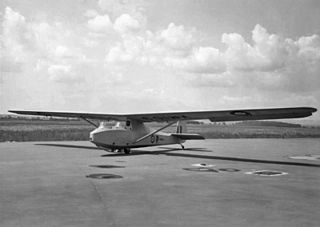Related Research Articles

The Slingsby T.30 Prefect is a 1948 British modernisation of the 1932 single-seat Grunau Baby glider. About 53 were built for civil and military training purposes.
The Slingsby Type 26 Kite 2 was a post World War II development of the Slingsby Kite, a single seat medium performance sailplane. It sold in small numbers.

The Slingsby T.24 Falcon 4 was a two-seat training glider designed in the UK just after World War II for ATC use. It was judged too expensive for production and only three were completed.

The Slingsby T.43 Skylark 3 was a single seat Open Class sailplane developed from the Skylark 2 with an extended wingspan. It won the 1960 World Gliding Championships.
The Buxton Hjordis was a single-seat sailplane built by Slingsby Sailplanes Ltd. in the UK to a design by G.M Buxton. Only one was constructed and was flown by Philip Wills at competitions in Europe between 1935-7.

The EoN 460 series are wooden single-seat standard class sailplanes, built in the UK in the 1960s. It did not have major competition success but some remain in use in 2021.

The Handasyde glider was a single-seat monoplane glider, designed specifically for the first British gliding competition held at Itford Hill in 1922, an endurance event. It finished in second place to a French tandem-wing machine.
The Sayers S.C.W. was a single seat monoplane glider, designed specifically for the first British gliding competition held at Itford Hill in 1922, an endurance event. Unresolved control problems stopped it from making any competitive flights, but it flew successfully later in the year. It was destroyed on the ground by a storm in December 1922.
The Merriam glider was a single-seat monoplane glider, designed specifically for the first British gliding competition held at Itford Hill in 1922, an endurance event. It crashed at the start of its first competitive flight but went on to be converted into a dual control training glider.
The Airdisco Phi-Phi was a single seat monoplane glider, designed specifically for the first British gliding competition held at Itford Hill in 1922, an endurance event. It recorded one competitive flight but crashed on a second attempt.
The Brokker was a single seat glider entered into the first British gliding endurance competition, held at Itford Hill in 1922. It combined the wing of a Fokker D.VII with an engineless Bristol F.2 Fighter fuselage. It flew well in the stiff winds of the last day and achieved the third longest flight.
The Peyret Tandem or Peyret Alérion, was a French single seat glider of tandem wing configuration. It won first prize at the first British Glider Competition of 1922.

The Abbott-Baynes Scud 1 was a parasol-winged single seat glider intended to introduce pilots to soaring flight. It was built in the United Kingdom and first flew in 1931.
The Latimer-Needham Albatross was the first British-designed and constructed sailplane, flying in 1930. Only one example of this single-seat, wooden aircraft was built.
The Nyborg T.G.N.1 was a single-seat experimental sailplane built in the early 1930s, its unusual wing design a scaled-up version of the wings of large birds.
The Penrose Pegasus was a 1930s high-wing, single-seat, wooden glider from the UK. Designed, built and flown by Harald Penrose until the start of World War II, only one was built at the time though a reproduction was constructed in the 1990s.

The Scott Viking 1 was a single seat, high-performance glider designed and built in the UK just before the Second World War. Only four were constructed, one setting records in Argentina and another remaining active into the 1980s.
The Stedman TS-1 City of Leeds was a parasol wing wooden sailplane, seating two in tandem open cockpits. Only one was built, by its designer in 1934; it remained active until the outbreak of World War II.
The RRG Professor was a very early soaring glider and the first to use a variometer for finding thermals. It was designed by Alexander Lippisch in Germany, first flying in 1928. The Professor was widely built by both flying clubs and factories.

Lore and a copy, Musterle, were high performance sailplanes designed at Darmstadt by Paul Laubenthal. Lore was flown successfully by the well known glider pilot Wolf Hirth at the 1929 Rhön (Wasserkuppe) glider competition. Musterle was used by Hirth used to demonstrate the possibilities of "blue sky" thermalling for the first time.
References
- ↑ Ellison, Norman (1971). British Gliders and Sailplanes. London: A & C Black Ltd. p. 16. ISBN 0-7136-1189-8.
- 1 2 "Gliding Competition". Flight . No. 28 September 1922. p. 559.
- 1 2 3 4 5 6 Ellison (1971). p. 67.
{{cite book}}: Missing or empty|title=(help) - ↑ "The British Gliding Competition". Flight . No. 19 October 1922. pp. 606, 609, 611.
- ↑ "The British Gliding Competition". Flight . No. 26 October 1922. pp. 624, 627, 629.